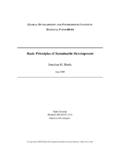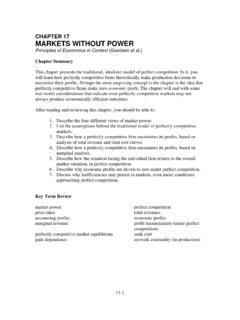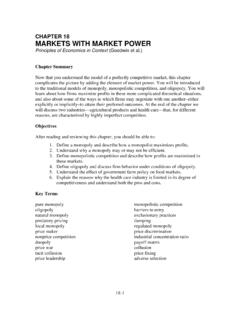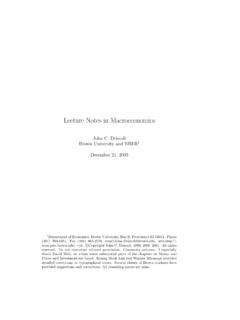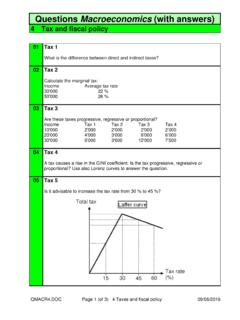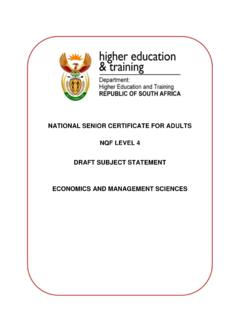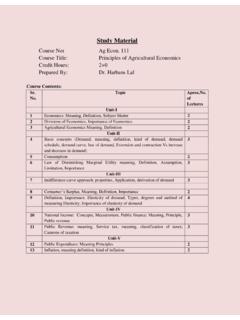Transcription of Chapter 7 Employment and Unemployment - Tufts …
1 7-1 Chapter 7 Employment and Unemployment macroeconomics In Context (Goodwin, et al.) Chapter Overview This Chapter introduces you to standard macro labor topics such the definition of the Unemployment rate, the different types of Unemployment , and theories of the causes of Unemployment . You will learn about labor market institutions and aggregate demand issues. You will also be introduced to the natural rate of Unemployment hypothesis. In the final section, you will be introduced to changes in labor force participation rates and questions of labor market flexibility. Chapter Objectives After reading and reviewing this Chapter , you should be able to: 1.
2 Explain how Employment and Unemployment are officially measured. 2. Explain why some analysts prefer measures of labor force utilization that differ from the official Unemployment rate. 3. Understand economists notions of frictional, structural, and cyclical Unemployment . 4. Describe the classical theory of Unemployment . 5. Describe theories of labor market imperfections. 6. Describe Keynes theory of aggregate demand, as it relates to wage levels and Employment . 7. Discuss the concepts of natural rate and non-accelerating inflation rate of Unemployment , and their relation to empirical evidence.
3 8. Describe some major changes in society and the nature of work life that have affected the relationship between Employment and well-being. Key Terms Bureau of Labor Statistics (BLS) employed person (BLS household survey definition) unemployed person (BLS definition) labor force (BLS definition) not in the labor force (BLS definition) Unemployment rate discouraged workers underemployment frictional Unemployment structural Unemployment cyclical Unemployment recession sticky wage theories insider-outsider theory efficiency wage theory natural rate of Unemployment non-accelerating inflation rate of Unemployment (NAIRU) 7-2 Active Review Fill in the Blank 1.
4 The agency that collects data on Employment and Unemployment is the _____. 2. Joe performed 15 hours of unpaid work on his family farm. He would be considered to be an _____ person, according to the BLS. 3. Marwan lost his job as an airline mechanic, and has been sending out his resume to other potential employers. He would be willing to start working in a new job immediately. Bill would be counted as an _____, according to the BLS. 4. Rachael says she wants to work and is available for work. She has recently looked for work but is currently not doing so. The BLS would call Rachael a _____ worker.
5 If she gives as her reason that she is no longer looking for work because there are no jobs for her, she would be considered a _____ worker. 5. The Unemployment that arises due to transitions between jobs is called _____unemployment, whereas the Unemployment that arises due to skills mismatches or geographic mismatches is called _____ Unemployment . 6. The theories developed by Keynesian-oriented economists explaining why wages may remain above equilibrium even when there s a surplus of labor are called _____ theories. 7. According to _____theory, workers who already have jobs at an organization may engage in actions that prevent competition from potential new employees and thereby keep their wages high.
6 8. Paying your workers higher than the market wage rate in order to improve productivity is an example of _____ theory. 9. Suppose the economy is at a full Employment equilibrium. According to the _____ hypothesis, the Unemployment that exists would be called the _____ rate of Unemployment . 10. Suppose that when the Unemployment rate falls below a certain threshold level, the inflation rate begins to rapidly rise. Some economists call that threshold the _____. True or False 11. The BLS s household survey and employer survey always get the same precise measure of the Unemployment rate.
7 12. The Unemployment rate is the percentage of the population that does not have paid Employment , but is immediately available and actively looking for work. 13. Almost all of the people who are unemployed are so because they have involuntarily lost their jobs. 7-3 14. Some economists question whether there is just one NAIRU (non-accelerating inflation rate of Unemployment ), and whether the NAIRU exists at all and is even a useful concept. 15. While the rate of unionization in the once reached over 30%, today it is only about 13%. Short Answer 16. Why is high Unemployment considered a bad thing?
8 17. Describe the two surveys the BLS uses to gather Unemployment data. 18. How does the BLS classify people who are not in the labor force, and what people are often in this category? 19. Why is it often said that the official Unemployment rate tends to underestimate the true extent of Unemployment in the economy? 20. What are the three major types of Unemployment ? Which of these three types of Unemployment tends to be spread broadly throughout the entire economy, as occurs as a result of a drop-off in aggregate demand? 21. What is the classical model s explanation for involuntary Unemployment ?
9 22. Identify two theories that explain why wages might be sticky at a higher than market equilibrium level. 23. Describe Keynes s theory of aggregate demand, as it relates to wage levels and Employment . Did Keynes believe that Unemployment is caused by sticky wages ? 24. Suppose the current Unemployment rate is 5%. How would an economist characterize the economy if the NAIRU was thought to be 4%? And if the NAIRU was thought to be 6%? 7-4 25. Provide two meanings of flexible work, in the context of macroeconomics and labor economics. Problems 1. The labor force as of May 2008 was million.
10 There were 146 million employed, and million unemployed. There were about million in prison. a. Calculate the official Unemployment rate. b. If those million people were not in prison, but were in the labor force and unemployed, calculate what the Unemployment rate would be. 2. Assume the labor market is represented by the graphs below. Illustrate the following scenarios, showing the shift in supply or demand for labor, ceteris paribus. On your graph, identify the new wage, quantities of labor supplied and demanded, and any Unemployment that exists. Note: This question draws on more than the graphs actually shown in Chapter 7.

